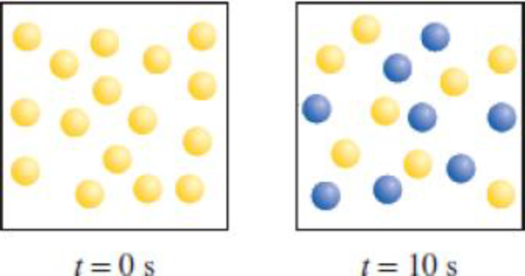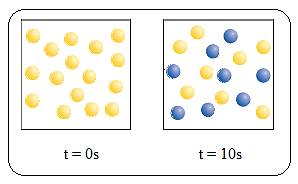
Consider the first-order reaction A → B shown here. (a) What is the rate constant of the reaction? (b) How many A (yellow) and B (blue) molecules are present at t = 20 s and 30 s?

(a)
Interpretation:
Half-life and the rate constant for the given reaction have to be determined.
Concept introduction:
Rate of the reaction is the change in the concentration of reactant or a product with time.
Rate equation for the general reaction
Half-life is the time required for one half of a reactant to react.
Half-life for a first order reaction is
Explanation of Solution
The given first order reaction is,
For first order reaction,
In the given diagram A molecules (yellow spheres) are converted to B molecules (blue spheres)

Fig (1)
There are 16 A molecules at
Using the following equation the rate constant of this reaction can be calculated.
Half-life for a first order reaction is
(b)
Interpretation:
The number of molecules of A and B present at
Concept introduction:
Rate of the reaction is the change in the concentration of reactant or a product with time.
Rate equation for the general reaction
Half-life is the time required for one half of a reactant to react.
Half-life for a first order reaction is
Explanation of Solution
The given first order reaction is,
For first order reaction,
In the given diagram A molecules (yellow spheres) are converted to B molecules (blue spheres)

Fig (1)
There are 16 A molecules at
Therefore,
At
At
Want to see more full solutions like this?
Chapter 13 Solutions
Chemistry
- A drug decomposes in the blood by a first-order process. A pill containing 0.500 g of the active ingredient reaches its maximum concentration of 2.5 mg/ 100 mL of blood. If the half-life of the active ingredient is 75 min, what is its concentration in the blood 2.0 h after the maximum concentration has been reached?arrow_forwardDerive an expression for the half-life of a a third order reaction;b a reaction whose order is =1; c a reaction whose order is 12. In these last two cases, examples are rare but known.arrow_forwardExplain why half-lives are not normally used to describe reactions other than first order.arrow_forward
- Sucrose, a sugar, decomposes in acid solution to give glucose and fructose. The reaction is first-order in sucrose, and the rate constant at 25 C is k = 0.21 h1. If the initial concentration of sucrose is 0.010 mol/L, what is its concentration after 5.0 h?arrow_forwardComplete the following table for the reaction below. It is first-order in both X and Y. 2X(g)+Y(g)productsarrow_forwardThe reaction of compound A to give compounds C and D was found to be second-order in A . The rate constant for the reaction was determined to be 2.42 L/mol/s. If the initial concentration is 0.500 mol/L, what is the value of t1/2?arrow_forward
- The decomposition of azomethane, (CH3)2N2, to nitrogen and ethane gases is a first-order reaction, (CH3)2N2(g)N2(g)+C2H6(g). At a certain temperature, a 29-mg sample of azomethane is reduced to 12 mg in 1.4 s. (a) What is the rate constant k for the decomposition at that temperature? (b) What is the half-life of the decomposition? (c) How long will it take to decompose 78% of the azomethane?arrow_forwardThe first-order rate constant for the decomposition of a certain hormone in water at 25C is 3.42104day1. (a) If a 0.0200 M solution of the hormone is stored at 25C for two months, what will its concentration be at the end of that period? (b) How long will it take for the concentration of the solution to drop from 0.0200 M to 0.00350 M? (c) What is the half-life of the hormone?arrow_forwardThree first-order reactions have the following activation energies: (a) Which reaction is the fastest? (b) Which reaction has the largest half-life? (c) Which reaction has the largest rate?arrow_forward
- The decomposition of N2O5 in CCl4 is a first-order reaction. If 2.56 mg of N2O5 is present initially and 2.50 mg is present after 4.26 minutes at 55 C, what is the value of the rate constant, k?arrow_forwardThe plot below shows the number of collisions with a particular energy for two different temperatures. a. Which is greater, T2 or T1? How can you tell? b. What does this plot tell us about the temperature of the rate of a chemical reaction? Explain your answer.arrow_forward
 Chemistry: Principles and ReactionsChemistryISBN:9781305079373Author:William L. Masterton, Cecile N. HurleyPublisher:Cengage Learning
Chemistry: Principles and ReactionsChemistryISBN:9781305079373Author:William L. Masterton, Cecile N. HurleyPublisher:Cengage Learning Physical ChemistryChemistryISBN:9781133958437Author:Ball, David W. (david Warren), BAER, TomasPublisher:Wadsworth Cengage Learning,
Physical ChemistryChemistryISBN:9781133958437Author:Ball, David W. (david Warren), BAER, TomasPublisher:Wadsworth Cengage Learning, Chemistry by OpenStax (2015-05-04)ChemistryISBN:9781938168390Author:Klaus Theopold, Richard H Langley, Paul Flowers, William R. Robinson, Mark BlaserPublisher:OpenStax
Chemistry by OpenStax (2015-05-04)ChemistryISBN:9781938168390Author:Klaus Theopold, Richard H Langley, Paul Flowers, William R. Robinson, Mark BlaserPublisher:OpenStax Chemistry & Chemical ReactivityChemistryISBN:9781337399074Author:John C. Kotz, Paul M. Treichel, John Townsend, David TreichelPublisher:Cengage Learning
Chemistry & Chemical ReactivityChemistryISBN:9781337399074Author:John C. Kotz, Paul M. Treichel, John Townsend, David TreichelPublisher:Cengage Learning Chemistry & Chemical ReactivityChemistryISBN:9781133949640Author:John C. Kotz, Paul M. Treichel, John Townsend, David TreichelPublisher:Cengage Learning
Chemistry & Chemical ReactivityChemistryISBN:9781133949640Author:John C. Kotz, Paul M. Treichel, John Townsend, David TreichelPublisher:Cengage Learning Chemistry: The Molecular ScienceChemistryISBN:9781285199047Author:John W. Moore, Conrad L. StanitskiPublisher:Cengage Learning
Chemistry: The Molecular ScienceChemistryISBN:9781285199047Author:John W. Moore, Conrad L. StanitskiPublisher:Cengage Learning





